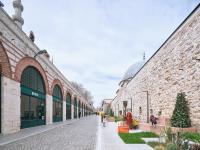As one of the most important historical buildings of Istanbul’s cultural heritage, the restoration project of the Row Shops in Süleymaniye Mosque Complex, was led by OzerUrger Architects and Emrah Köşgeroğlu and reopened by Istanbul Metropolitan Municipality with the function of design museum.
Süleymaniye Complex Row Shops form a part of Süleymaniye Complex, which was built between 1551 and 1558 and accepted to the world heritage list (UNESCO) on 06.12.1985. The row of shops starts from Mimar Sinan tomb and extends along Mimar Sinan Street. The complex, which is a social centre consisting of more than one building and function, has an important place in Ottoman social and cultural life. The rows of shops are an important part of this multi-purpose complex with a focus on production and trade. Süleymaniye Mosque, one of the most important symbols of the city's identity for centuries, was built on a hill overlooking the Golden Horn.
The complex structures that Mimar Sinan skilfully placed on the hill, the surrounding buildings and the retaining wall that today runs along Mimar Sinan Street were used for filling and clearing works to create the platform on which the mosque sits and to level the area. The resulting height differences in the direction of the Golden Horn were taken advantage of, and shops were placed in the gaps created by the walls used to level the courtyard of the mosque. The same craftsmanship is evident today in the graceful descent of the Rabi and Salis madrasahs to the lower level.
The shops consist of square cubicles with dimensions of approximately 4m x 4m. The section of the shop row facing the Salis-Rabi front consists of 34 units, and the part under the Darü’-hadis Madrasa comprises 18 units. During the Ottoman period, these shops cast copper items used in daily life and metal parts used in construction. Over the years, the shops suffered damage due to changing production-oriented functions. Additionally, with increased tourism pressure in the area, demand for space and the scope of interventions have grown. The resulting issues necessitated field interventions.
While the original plan of the rows of shops has been preserved, the facades have suffered damage, and their original condition has been lost. Furthermore, interventions made due to an 80-90 cm elevation of the road have also harmed the facades.
Interventions in the field carry significant responsibilities and opportunities. First and foremost, restoring the buildings that form Mimar Sinan Street, which played a central role in Ottoman commercial life, is crucial. Equally important is determining how the building will be repurposed. The project focuses on resolving the contradiction between preserving the original production-oriented use and meeting the demand for space for tourist goods.
To achieve this, the project broadens the user profile and develops suggestions for locals, students, and researchers to visit the area in addition to tourists. The shops that produce and sell on-site, with traces still remaining in the area, serve as the starting point. This perspective, introduced during the project phase, facilitated the adaptation of the design museum concept that emerged after the completion of the buildings.
In transforming the area into a cultural and commercial hub, the content of the shops is as important as the relationship they establish with the street and the overall street texture. Consequently, the space created from the demolished shops in the opposite row of the project was designed as a public open space, offering an alternative social area where visitors to the region can spend time. The project also involved redesigning street pavements, sidewalks, and border elements, thereby improving the relationship between the shops and the street.
2024
2024
Total Construction Area: 850 sqm
Project Team: Ahmet Mucip Ürger, Ali Özer, Emrah Kögeroğlu, İsmet Güngör, Utkan Kurucu, Ercan Koca
Restoration Project: Ozer\Urger Architects, Emrah Köşgeroğlu











